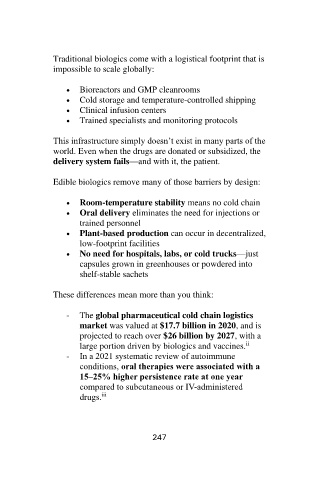Page 249 - Binder2
P. 249
Traditional biologics come with a logistical footprint that is
impossible to scale globally:
• Bioreactors and GMP cleanrooms
• Cold storage and temperature-controlled shipping
• Clinical infusion centers
• Trained specialists and monitoring protocols
This infrastructure simply doesn’t exist in many parts of the
world. Even when the drugs are donated or subsidized, the
delivery system fails—and with it, the patient.
Edible biologics remove many of those barriers by design:
• Room-temperature stability means no cold chain
• Oral delivery eliminates the need for injections or
trained personnel
• Plant-based production can occur in decentralized,
low-footprint facilities
• No need for hospitals, labs, or cold trucks—just
capsules grown in greenhouses or powdered into
shelf-stable sachets
These differences mean more than you think:
- The global pharmaceutical cold chain logistics
market was valued at $17.7 billion in 2020, and is
projected to reach over $26 billion by 2027, with a
ii
large portion driven by biologics and vaccines.
- In a 2021 systematic review of autoimmune
conditions, oral therapies were associated with a
15–25% higher persistence rate at one year
compared to subcutaneous or IV-administered
iii
drugs.
247

